Pan, an ancient deity, was the guardian of the flocks and his mission was to make them multiply. God of forests and pastures, protector of shepherds, he came into the world with the horns and legs of a goat. Son of Dríope, one of the Pleiades, and Hermes, the messenger of the gods, being considered the intermediary god, it was natural that he established the transition between the gods in human form and those in animal form.
However, Pan was abandoned by his mother at birth, frightened by his strange formation, with goat's feet and horns on his forehead and a bushy beard. When Hermes took his son to the temple, all of Olympus ridiculed the child. In view of this, Hermes asked that the child never call him father.
He was feared by all those who needed to cross the forests at night, because the darkness and solitude of the crossing provoked sudden fears, devoid of any apparent cause and which were attributed to Pan; hence the name panic. The Latins also called him Faunus and Silvanus. The nymphs incessantly mocked Pan because of his repulsive face, he made up his mind never to love. But one day, wishing to fight hand to hand with Eros, he was defeated and slaughtered before the laughing nymphs.
Walking through the woods he found the nymph Syrinx, daughter of the river-god Ladon, Syrinx had never wanted to receive homage from the deities and had only one passion: hunting, but Pan fell madly in love with her. Owner of great beauty, Syrinx was used to fleeing the attacks of men and gods. But with Pan it was different. He had the ability to run through forests and mountains for long periods without tiring, and he pursued Syrinx for days across valleys, hills and forests. Exhausted and unable to escape her clutches any longer, the nymph ran to the riverbank, calling for help from her father and her sisters, the Ladonides nymphs. Moments before Pan's arms encircled her body, she vanished into thin air and turned into wild reeds.
Enraged, Pan broke the reeds to pieces. A strong wind blew through them and the sound emitted sounded like the sweet melody of Syrinx's voice. Filled with grief and melancholy, the satyr gathered some of the pieces of reeds, bound them together with wax and thread, and fashioned a flute, known from that day forward as Syrinx's flute or Pan's flute. According to mythology, he never again parted with the instrument, which represented his lost love.
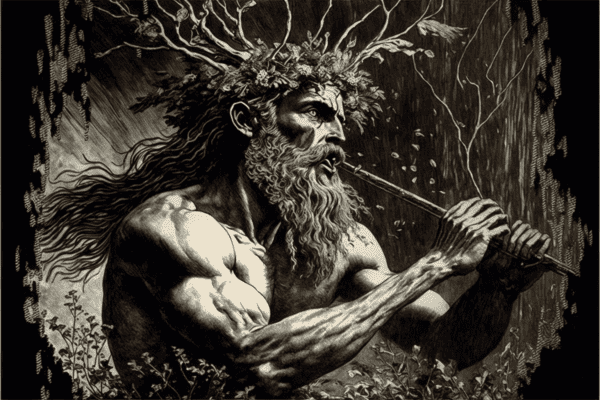
Cupid announced to him that the amorous sounds of the flute would attract, despite his grotesque appearance, the beauties who disdained him. Indeed, soon the melodious sounds of the flute attracted the nymphs from everywhere who came to dance around the horned god. The nymph Pythys was so moved that Pan was reborn with hope, believing that her talent would make her face forget.
Always playing the seven-pipe flute, he began to look for solitary places and finally noticed a steep rock on top of which he decided to sit down. Pitys follows him and, in order to hear him better, gets closer and cad . Pan seeing her so close, he judged the opportune moment to speak to her. Pitys was loved by Boreas, the terrible north wind, which at that moment was blowing with great violence. Seeing her beloved, she had a fit of jealousy and, not being able to contain herself, she blew with such impetuosity that the nymph fell over the precipice. Immediately Pitis's body was transformed into a pine tree. Pitis in Greek means pine, consecrated to Pan. For the same reason, in figurative representations, Pan's head is crowned with pine branches.
However, Pan's destiny was to love without ever being able to unite with the beloved creature. Continuing to make music on the mountain, he heard a tender voice at the bottom of the valley that seemed to repeat his melodies. It was the voice of the nymph Echo, daughter of Air and Earth. Though he followed her and she responded, he could never catch up with her. So Pan dwelt in caves and wandered through the valleys and mountains, hunting or dancing with the zen , always carrying a flute with him.
Pan is also a figure associated with the world as a whole, since it is the representation of what is meant by nature and the universe. He was represented as a god in neo-pagan religion, whose spirits interact with nature. In the Middle Ages, the Catholic Church associated the god Pan with the Devil.
Reference:
http://eventosmitologiagrega.blogspot.com/
https://www.mvim.com.br/em-pauta/o-deus-pa-e-sua-flauta/








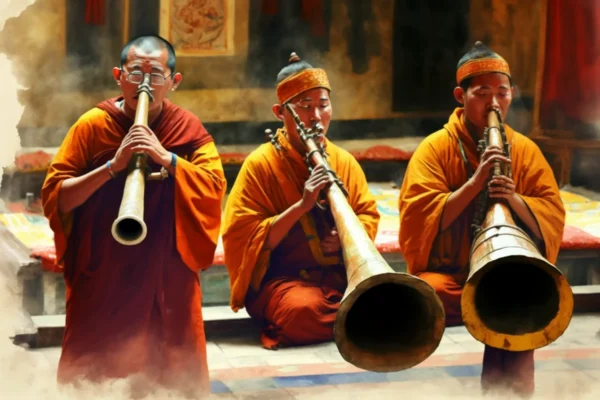

wonderful mythological fable, very well elaborated, delicious to read and know this story of Pan, Syrinx, I really enjoyed knowing this mythological story.